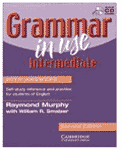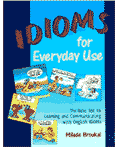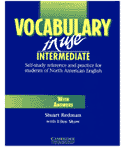| Home | Resources | About | Contact | |||||||||
|---|---|---|---|---|---|---|---|---|---|
 |
|||||||||
|
|
They should've gained a good level of confidence and has gotten rid of their fear to speak. Now you can be a lot more creative in class and actually tell some jokes they may understand. What you want to do is encourage more conversation and start having them do simple compositions. And of course move to more advanced grammar. I recommend here the...
You can start throwing some idiomatic expressions into the mix. The
two books I recommend for this are...
One thing my students like to do is to write compositions. For those who really want to learn English it's a challenging exercise and it gives them the opportunity to bring all their knowledge together and be creative. Want help planninng your lessons? You can...
I was going through a old bookshelf of ours that contains some very old books, some of them editions of Shakespeare from the 1800's. I came across a big book whose binding was in shambles. It was a book of bedtime stories for children copyrighted in 1955. Each story is one page long and for each day of the year. It is written in simple English but there are words and ideas in there that even my Advanced students haven't seen. Here's how I use this book: I pick a story and make copies for each student. I read a few sentences slowly then go around the room and have a student read the same passage. Then I read another passage and have the next student copy me while I correct pronunciation and intonation and so on until the entire story is read. Next, we go back to the beginning and go through it sentence by sentence talking about new vocabulary and concepts. Sometimes this might lead into some questions from the students and take us on a tangent into a different subject for a few minutes. This is OK. We're speaking English and the students are engaged. Tangents can be interesting and keep the attention level and entertainment value of the class up. (And, yes, I don't care what anyone says, you are there to entertain. It's been proven that people learn faster in a fun and playful environment. So keep smiling and keep the students engaged.) Most likely after I get through the vocabulary for the whole piece the hour is done. What's great about these little stories is that they're usually good for an entire week. This is how I proceed: 1. I do the first exercise described above with reading out loud then work on the vocabulary. 2. Next class we'll review the vocabulary and concepts. I guarantee most have forgotten what the words mean even if they've written the meanings down. They sometimes don't get the meaning the first time you explain and they might have written down some bizarre definition. 3. Then we do dictation. I read through the part I am going to dictate, usually just the first half and have them read along. I sometimes have them read along with me out loud. Then I have them take out a clean sheet of paper and dictate it to them sentence by sentence, phrase by phrase. Then I say "check your work" and when they are finished have each tell me how many they got wrong. But I never make them feel bad for their mistakes I usually just say "thank you." Sometimes I'll joke with them, especially the better students, and say "What! You got ten wrong?!! Oh, my God!" 4. The next day I'll do dictation again reading the next part of the passage first while they read along. We may discuss the vocabulary beforehand. 5. Another thing I might do is do a little word game. I'll write on the board all the new vocabulary words. Then I'll give the meaning of the word and ask them to match the meaning to the word. You can also do this as a little written quiz if you want. And if any words have antonyms or synonyms or homonyms you can work with this too. It keeps them guessing and the class interesting. 6. After we do the dictation and vocabulary game I pick a word and have them write a sentence with that word. And then go around and have each student read their sentence in class. Some of the sentences are right on, others are out in left field. I do my best to correct the sentences right in the moment, all the time, of course, being encouraging to the student. Some of the sentences are downright funny and it's OK to laugh as long as you correct the mistakes and make the student feel good for making the attempt. 7. The last thing I do with the story is have them write a composition
offering three variations they can choose from:
I usually give them about 15-20 minutes then have each student read the story out loud correcting the sentences as they go along. Another thing you could do is have them rewrite the story but do it in a different tense such as rewriting it in the present or in the future tense. This children's book mentioned above is out of print and I don't know where to find another one. Perhaps if you go to Barnes and Noble you might be able to find something similar in the children's section. Children's books are great for teaching ESL. ESL Lesson Plans for Beginner Students -- Level One ESL Lesson Plans for Upper Intermediate Students -- Level Three ESL Lesson Plans for Advanced Students -- Level Four
|
||||||||



